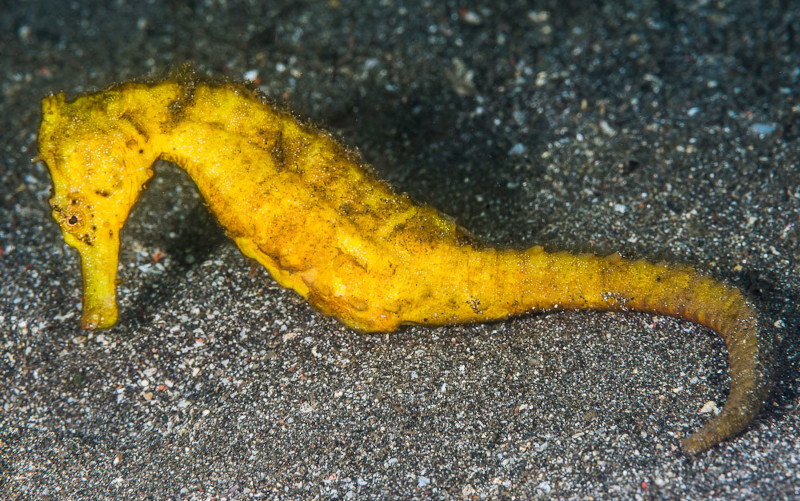
Spotted Seahorse Facts
- This eye-catching creation of Nature most freuently goes by the fully descriptive common name of the Spotted Seahorse. Yet, it also has other general titles. These include such similar terms as estuary seahorse, yellow seahorse, and common seahorse.
- Within the scientific community, however, that animal is likely better known by its technical moniker. Thankfully, that’s a relatively simply term for the layperson to pronounce, as such things go. That’s because it holds the epithet Hippocampus kuda.
- This beautiful creature received that designation due to the efforts of Pieter Bleeker. The respected This Dutch ichthyologist achieved the first recognition of it as a separate and distinct species He also accomplished that noteworthy feat in the year 1852.
- This marvel of Nature, along with its numerous relatives, and cousins, the sea dragons, stand out for an extraordinary reason! These represent the only known animals on earth in which the males give birth! It’s truly a remarkable evolutionary adaptation.
- Sadly, the amazing Spotted Seahorse now finds itself in an unfortunate situation. In its native environment, its population numbers appear to be dwindling. Due to this regrettable fact, the IUCN presently lists it as Vulnerable on its published Red List.
- It faces multiple threats to its continued existence as a species. Like all species on earth today, though, most of these stem from the actions on makind. They include, among others, the related dangers of habitat loss and ongoing climate change.
Related Articles
Spotted Seahorse Physical Description
The fabulous Spotted Seahorse rarely fails to captivate those lucky enough to view its natural beauty. This marvel of creation, however, also impresses one due to attributes of size, as well. That’s true since it’s not just a pretty face, but a large member of its Genus, too.
The animal also follows a pattern prevalent among fauna around the globe. That’s in the fact that it displays a certain degree of the physiological characteristic of sexual dimorphism. In its case, however, this physical trait manifests in a surprisingly wide variety of ways.
Males tend to be slimmer in general body shape, for one. These, however, possess a brood pouch for the young, that the females conspicuously lack. In some cases, there may also be some subtle differences in coloration between males and females of this awesome species.
Overall, though, the general appearance remains roughly the same between the genders. Fully mature adults typically attain total lengths measuring between 10 to 15 centimeters (4 to 6 inches) in length. Exceptional individuals sometimes exceed even this, however.
The Spotted Seahorse has an elongated body structure encased in bony plates. Its body is tubular in shape, with a distinct lack of scales. Instead of these, it has a thin layer of skin stretched over bony plates. This skin can change color to some extent, aiding in camouflage.
Its distinctive head is elongated and somewhat horse-like in appearance, hence its name. The small mouth is located at the end of a tubular snout. The eyes also develop as large and move independently of each other, allowing them to scan their locale for prey and predators.
The animal also has a prehensile tail that it uses to anchor itelf to objects such as seagrass or coral. This tail is highly flexible and can coil and uncoil to grip onto various surfaces. The fish also has both dorsal and pectoral fins, the latter located on either side of its body.
- Kingdom: Animalia
- Phylum: Chordata
- Class: Actinopterygii
- Order: Syngnathiformes
- Family: Syngnathidae
- Genus: Hippocampus
- Species: H. kuda
Spotted Seahorse Distribution, Habitat, and Ecology
Fortunately, the lovely Spotted Seahorse evolved as native to an impressively broad swathe of the marine regions of the globe. The full extent of that zone of habitation, however, might surprise some of you. It’s even possible the natural wonder once appeared even further.
The amazing creature lives in the Indo-Pacific region. Its distribution extends from the Indian Ocean to the western Pacific Ocean. Waters it inhabits include those of the Persian Gulf to Southeast Asia, Australia, Japan, and several Pacific islands including Hawaii.
In all regions it calls home, though, it displays a mixture a clear preferences and flexibility regarding its choice of habitat. The animal primarily resides closer to shore, rarely appearing at depths greater than 180 ft (55 m). Here, however, it finds many regions to inhabit.
It’s commonly found in areas with sandy or muddy substrates, although it also sometimes inhabits seagrass beds, coral reefs, and rocky areas. Yet, it also frequently lives in regions of mangroves, or, even less commonly, occasionally being found on some coral reefs.
Like its many relations, the marvelous Spotted Seahorse developed as carnivorous in nature. Its natural diet consists principally of a variety of tiny crustaceans, zooplankton, and other small organisms. It also typically feeds as an ambush predator, lying in wait for its prey.
It in turn, however, faces its own share of predators. These include a wide range of species, including various larger marine animals, including fish, crabs, and seabirds. On an individual basis, its ability to camouflage itself represents its only real defense against this.
Species Sharing Its Range
Check out our other articles on 4 Incredible African Insects, Amazon River, Southern Elephant Seal, Phillip Island, Snake’s Head Fritillary, Old World Swallowtail, Rose’s Ghost Frog, Orinoco Crocodile
